Archive for the ‘Qigong Lessons’ Category
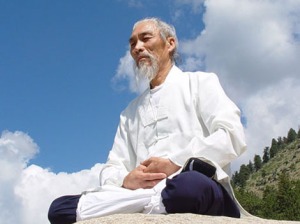
Taoists use a skill called “Tu na” to tune their breath before doing qigong and meditation. Natural Breathing (Shun Hu Xi) is the best place to start.
Effective meditation and qigong both require good breathing skills; this lesson will give you a method that you can use every time you start your practice. This exercise takes about 5 or 6 minutes to learn, and after a few times you can tune up in about 2 minutes.
I should begin by saying to just breathe naturally, beware of complicated methods; they are not necessary and can even be harmful. In addition, know that generally Taoist breathing is subtle and you should not even hear yourself breathe. In this method make each inhalation and exhalation of equal duration and breathe in and out from your nose.
Like a fine musical instrument, no mater how well it is played, if you want to make beautiful music you need to tune it up first, until it is harmonious within itself it will not give quality results.
Begin by standing in Wuji Stance, now bring your arms just slightly around in front of you and allow them to hang with the hands in front of your thighs. The first step in tuning the breath is to pay attention to each one of the points along the journey of the breath. Just like a guitar with six strings, a musician tunes one string and then the next in sequence tuning the instrument to a playable condition; I have identified six locations along the path of the breath to assist you in tuning your breath.
Once each location is dialed in we can follow the breath through each one sequentially as we breathe; just like strumming the six strings of a guitar chord. Then we will feel the body resonate; the whole body vibrates just like the body of a guitar. This vibration will float the arms and pull the legs straight as we feel the energy rising with each inhalation.
First we start with the nose, and then continue down to the back of the throat just behind the tongue and then moving further down we come to the trachea. The next step down from there are the actual lungs and then the diaphragm and finally the dantian.
All I want you to do initially is to stand still and breathe in and out your nose. Pay attention to the air going in and out of the nose and you may notice the nostrils flaring and the hairs inside the nose moving back and forth and even whatever scents are in the air coming in. Just take a few breaths to get comfortable noticing that part of your breath path, just breathe in and out…
Next, bring your awareness to the back of the mouth where the tongue starts its descent into the throat. Feel the air cascading over the back of the tongue and epiglottis, it may feel just a little raspy as the air goes over this area. Another sensation you might feel is saliva welling up in the heavenly pool beneath the tongue. Just like before, take a few breaths with your awareness on this location until you can feel the breath there.
The next location on the journey from the nose to the dantian is the trachea. With each breath you will feel the windpipe expanding and you may even notice slight pressures on the thyroid gland as the trachea expands. Feel the air moving through the larynx and the windpipe expanding slightly as the air reaches the lungs. Again, take a few breaths at this location until you are comfortably aware of these sensations.
Now you should feel the air entering the lungs and the top of the lungs expanding slightly. As the air enters your lungs feel the sternum rise and the rib cage expand slightly, keep your awareness here for a few breaths and pay attention to these sensations.
As the lungs fill with air, bring your awareness down slightly lower to the diaphragm muscle at the solar plexus. If you pay attention here you can feel the diaphragm muscle descending upon each breath just as the air starts to enter the lungs. Keep your awareness at this location until you are sure you can feel the diaphragm muscle moving down and up with each breath.
Beneath the diaphragm, bring your awareness to the dantian, now you are in the abdominal cavity. Notice the pressure the descending diaphragm puts on the internal organs. This gentle massaging motion causes your abdomen to move out slightly. Just keep awareness at this location until you can feel the diaphragm pushing on the internal organs and notice that your belly rises and falls with each breath.
Your awareness of each part of the breath is in now enhanced and you are almost all tuned. Like the individual strings of a guitar; one by one each area is in tune with the one next to it. Now bring your awareness back to the nose, this time, follow each breath as it goes through the nose, past the tongue at the back of the throat and moves down the throat and trachea into the lungs. Notice how the diaphragm moves down and up and the dantian moves out and in with each breath. Continue to follow the breath with your awareness as you do all of your various practices that follow.
Now that you have tuned each area and you have followed the path of the breath from top to bottom and from bottom to top you should notice a resonant frequency in your body. Remember your hands lying just in front of your thighs, with the upper arms slightly against the side of your chest? With each breath and subsequent expansion of your abdomen your arms will rise approximately 1 inch away from the dantian. Follow this rising feeling of each inhalation as you inhale and the chest expands, feel the chest rising and the hands floating upwards slightly. Simply let this rising feeling pull the legs slightly straight; remember you were standing in wuji stance with bent knees but now the expanding nature of the breath lifts the whole body up and the legs straighten slightly. When you exhale bend the legs slightly, just allow the hands and arms to float down from their elevated position as the air leaves your lungs and the rib cage returns back to its contracted position.
Each time you breathe you will feel the air come in the nose, past the throat, through the windpipe into the lungs the diaphragm moving downwards and the belly moving out and the hands and legs slowly rising as you fill with air. Each time you exhale as the abdomen contracts and the arms descend, bend your knees slowly back to the beginning position.
Congratulations, you have tuned your breath and you are now doing basic qigong. All you need to do now is continue to pay attention to the tuning of the breath and let the body move in a rhythmic fashion.
I suggest you tune your breath while standing before doing seated qigong and meditation as well. It is much easier to feel the expanding contracting nature of the breath and body while standing. Once the system is tuned and playing along harmoniously with the body moving rhythmically you may commence doing any qigong form that you wish. Simply breathe slower or move the arms and legs faster to keep the timing consistent and with a little practice to be able to do all the qigong you want while keeping the breath tuned continuously.
Whether moving or still, all qigong and meditation practices are more effective by tuning the breath before you proceed; remember, just keep breathing steadily.
Copyright Cory Williams 2011
Next, try here: Qigong Lesson #1
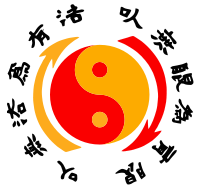
This is Bruce Lee’s Jeet Kune Do Symbol “Using no way as way” & “Having no limitation as limitation”. The arrows represent the endless interaction between yang and yin
The focus of the last qigong lesson was to introduce the properties of Yin and Yang in the human energy system as it pertains to Qigong practice. One of the first things qigong students learn is the difference between the way yin and yang manifest during practice. This basic understanding is the starting point to getting to know your energy. Eventually this awareness of yin and yang will be discerned in all of your energy systems.
There are many different “energy systems” in the human being and all of them have yin and yang elements. For example in basic qigong practice the most obvious energy system in the physical body are things like muscles and bones; pneumatic (breath) and hydraulic (blood and lymph) but there are others such as mental, emotional, spiritual, electrical (nervous), and chemical, like hormones and neurotransmitters.
The reality of life is there are no absolutes; energies are always in ebb and flow. In the last lesson I used a diagram showing the separation of yin and yang, this is only to get a basic understanding of the rise and fall of the energy; this symbol could be called Yin AND Yang. The Taiji symbol is sometimes called the Yin/Yang diagram. Do see the difference between the two? Yin and Yang or Yin/Yang, the difference is the first one defines yin and yang as distinctly different and separate things; the second one shows the harmony between the two.
In the title to my web site, I say “Balance and Harmony for a better life.” Balance and harmony is a common phrase; some people reverse the two words however saying “harmony and balance.” To my mind though, you need balance before you can have harmony. This is an important point for you to realize in your training as qigong and Taiji works on us to first balance our energy so that we can harmonize with reality. Again this is true whether we are talking about emotions or our bodies…. For example, if we have balanced emotions then we can harmonize with others.
Harmony is what we get when we have all our energy systems working together in a synergistic way. Synergy is a good word, it is when the sum is greater than the parts; you know, sort of like one plus one equals three. Now while some of our energies may be “Yang” there will be others that will be “Yin.” For example, my mind may be yin while my body is yang, while at the same time my legs may be yang while my arms may be yin and my emotions could be yin while my spirit is yang!
Yet it all works together in harmony. When the thinking mind is softened and yin, the spirit fills with energy and could be considered yang. When I am moving my body upward there is energy coming up from my legs which could be considered yang at that moment yet I keep my hands soft (with my mind) making them effectively yin. Yang leads and yin nurtures. For example my intention (yang) tells my body to relax (yin) the relaxed body attracts energy to flow into it, yang. Lets say for example, the energy (in the form of blood pressure) is down in the legs, (yang) then, when we relax the hands (yin) the energy will flow into them, and back and forth filling and emptying.
While doing qigong notice how you can control the flow of energy when doing the movements by sequentially relaxing and expanding. As you are alternately flexing and relaxing different groups of muscles, you can lead the qi through your body. Remember, the energy wants to flow into emptiness just as electricity seeks a ground or water (and air) flows from high pressure towards low pressure. In the great source book of Taoism, the Tao Te Ching, Lao Tzu tells us, “The sage leads by following, by putting himself beneath others they all flow towards him.” Can you see how the philosophy of Taoism teaches us how to be better people?
Learning to be both yin and yang at the same time (yin/yang) is like bringing together the two halves of who you are. We all have yin and yang elements in play in every part of who we are. Proper qigong and Taiji is all about learning to first balance our energies and then to harmonize all these different energies so that we can find the reality that we need not be so polarized in life as to lose sight of the “big picture”
Like two horses…. The mare and the stallion, named yin and yang…
The stallion leads the way with the nurturing mare just behind him, giving him encouragement and moral support. She wants him to lead, and he enjoys doing the hard work of blazing the trail and such. The clever mare knows how to get him to lead where she wants to go by using her soft nurturing way, and he is glad to go where she wants him to. The two move in harmony due to the balance of their complementary energies.
Go to Qigong on Maui web site
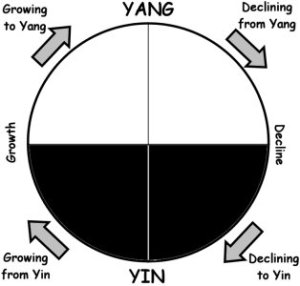
Yin AND Yang separated
In the first three lessons, I discussed how we align our physical bodies with the forces of Heaven and Earth. This lesson is about learning the difference between the two main aspects of our Qi using the concept of Yin and Yang.
Realize that there are two major forces acting upon us at all times, the first and most obvious is the force of gravity, we all understand what that is. There is however another, balancing force in play as well, that of centrifugal force. As the earth spins at about 6000 miles per hour trying to throw us off it, we are at the same time held fast by gravity. (Physicists would disagree, but I’m just illustrating a point) In another way of viewing it (the Taoist way), we are suspended between the two forces of Heaven and Earth.
Think of “Earth” as the pull of gravity, pulling directly towards the center of the planet. Know it is Yin and, elemental, sinking and compressing downward, everything heavier than air flows towards it. The only way we know which way is up is because we know which way is down!
Think of “Heaven” as that centrifugal force that is lifting us directly away from the center of the Earth; in Qigong parlance, “the golden thread from Heaven” this force is Yang, and ethereal. Lifting and expanding upwards, everything lighter than air, including electrical energy floats weightlessly.
Beginners on the way of Qigong first learn to feel and understand these two different aspects of energy, adepts move beyond the understanding of discerning yin and yang to get to a point where they harmonize yin/yang.
To better learn how to feel Yin and Yang, consider two main types of qi, Yeng qi and Wei qi. Yeng qi is all that stuff that sinks down through our bodies as we relax and let it sink, things like blood, lymph, muscles, organs, a thick viscous downward flow of all our soft tissue.
Think of Wei qi as all that stuff that floats like our electrical signals our nervous system releasing neutral density neurotransmitters into our system like endorphins… our emptied muscles and bones and our breath.
After you understand this concept, you are ready to apply the knowledge to Qigong exercise.
When you relax your body, the blood and lymph and all the soft tissues sink lower into your body; this is the Yeng qi sinking. As this material sinks down, the blood filters through the lymph nodes, and the fascia tissues relax and a curious event occurs. The Wei qi is displaced and it rises up giving you a buoyant feeling. The more you can sink and relax downward, the more you can expand and feel buoyant going upwards.
You are learning to flow all the Earth (Yin) elements (Yeng qi) downward causing the complimentary effect of all the heavenly (Yang) elements (Wei qi) to rise and expand. These dynamics act like an energy pump, sinking down stimulating a return to an upright posture, you are learning to discern Yin and Yang: a major milestone on the qigong path.
More Here: Qigong Lesson #5
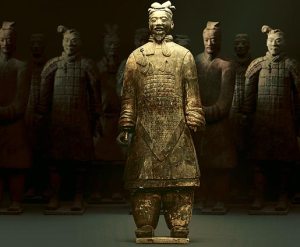
One of over 8000 thousand life-size Terracotta Warriors standing strong for over two thousand years
Zhan Zhuang “Standing like a post” Standing Meditation
Standing builds structural integrity in your physique, calms the mind and emotions and it provides a foundation for internal qigong work known as “nei gong”.
As you are learning to connect with your internal energy, many new and intriguing adventures will open up to your awareness. In fact, awareness is the primary connection that you make as the path unfolds before you.
You can reach your health goals whatever they may be, whether they are physical health, as in posture, flexibility, balance or general strengthening or mental goals such as, improved memory, freedom from excessive thoughts or disordered thinking, or perhaps emotional goals like curing frustration, mania, anger, fear, grief, worry, depression or whatever else.
The one common denominator in almost all ailments is unbalanced energy within you. Even the most devastating illnesses often have their roots in basic problems with your personal energy and many are therefore preventable. Balancing our energies is the goal of all traditional Chinese medicine and Qigong is a basic part of TCM.
In the first two Qigong “lessons” here on this blog, I outlined the first skill you should master, Wuji. As the name implies Wuji is a starting point and it is where we begin all qigong exercises and the Taiji forms, yet there is a whole genre of “Wuji training” that can be explored.
Standing is sometimes called zhan zhuang, which means “standing like a post”, or referred to as standing meditation; it is in fact an excellent qigong exercise all by itself. There are no real ”forms“ per se, instead individual postures are sustained for a length of time as necessary.
The main goal here is to balance out our internal energy by standing still, however stilling your body often encourages thinking to arise; sometimes the thinking can become overwhelming. Redirect your thoughts into becoming aware of the 12 points outlined in the last lesson and only allow your thoughts to go through the “postural check list”.
Another technique to stop unnecessary thinking, is to simply count your breaths; paying attention to the air moving in and out as you do. When you find yourself caught up in a daydream, just start over with the alignment and then find your way back to your breathing; in this way you will learn to dissolve your mind and body together.
After we still our bodies, and refocus our thinking, errant energy tends to go into the emotions. This can be very annoying as thoughts and emotions are linked, often emotional thoughts like: “I feel dumb standing here”, “What are others thinking about me seeing me standing here?”, or “Am I wasting my time standing here?” Any excuse we can dream up to release us from learning about our true selves seems like a good enough reason to stop our training. Just go back through the same routine and you will find these emotions subside.
While standing in a posture, there are many other techniques that you may apply, such as various breathing practices and a whole host of higher-level skills known as “nei gong“. These skills will be explained in future articles about that topic but the first step into that whole universe of qigong arts starts with zhan zhuang.
To perform zhan zhuang all you need to do is stand, correctly of course, in any one of numerous postures. To avoid an emotional reason to give up, commit before hand to doing zhan zhuang for a certain length of time, say 10 or 15 minutes. You may stand in Wuji, or pick some postures from the Taiji form. In the beginning I recommend you attempt at least three minutes in each posture, that way you will not get bored so that during the 15 minutes you could manage five postures. Serious zhan zhuang practitioners may stand for up to an hour in one or two postures!
In coming lessons, I will show you some postures that can be used in addition to the ones you are learning as part of a Taiji class. Who knew that by just standing you could accomplish so much without knowing any forms?
Stand strong and you will develop good balance, strength, and energy.
Copyright Cory Williams 2010
More here: Qigong Lesson #4
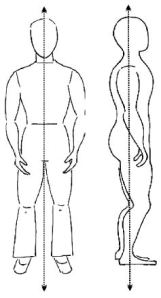
You need to know where you are in order to find your way.
Your place in the universe is often twisted away from the ideal; it may be physical, mental, emotional,and/or spiritually misaligned.
Let me first explain that in the “physical world” you can be physically, mentally, emotionally,and/or spiritually misaligned and you can also be misaligned in the “celestial world”. This is because all things have Yin and Yang elements to them. Our goal is harmonizing Yin/Yang, not just balancing Yin and Yang .
To keep things simple, my objective in this article is just to start with the body, the physical within the physical.
The most important overriding principles in Qigong and Taiji and Meditation for that matter revolve around alignment. As stated in the second paragraph of this page, alignment could mean spiritual, emotional. mental, or physical.
As we work ever inward to the higher levels of understanding we need to start somewhere. The starting point is the physical alignment of your body, starting with your feet. When we learn this basic skill called “Wuji Stance” we will have a working model of alignment that we can “clone” into our thinking to restructure our bodies, minds, emotions, and ultimately our spirits. Then we can keep feeding back that spiritual energy to continually strengthen our bodies, minds, emotions. The cycle continues until we have the “rarefied qi” of original Spirit known as “the gold pill” a spiritual embryo that grows within us until such time as it “becomes” us and we are reborn into Tao.
It is simple really. Just start under your feet. We want a totally natural alignment of our skeleton so we can relax all of our muscles. The following list is an example of what I tell my students. I probably say this list fifty times a week in my classes…..
1. Feet parallel and shoulder width apart
2. Knees slightly bent
3. Tailbone tucked in so your lumbar spine is vertical
4. Relax the hips and “sit” into your legs
5. Let the “golden thread from heaven” lift your head
6. Tuck in your chin so that your cervical spine is vertical
7. Relax your shoulders, let your arms dangle at your side
8. Contain your chest, don’t “puff out” your chest
9. Bring your breath to your dantien, just below the navel
10. Bring your mind down to your dantien
11. Put your tongue at your palate
12. Keep your eyes soft, don’t strain your eyes
In addition I tell students to: keep their hearts open, explaining that there is no need for any emotional energy, and to keep their mental energy redirected inward, reviewing the 12 points on the list. Then I repeat the list….
Now you can start right away by learning to Tune your Breath
Copyright Cory williams 2009
more here: Qigong lesson #3
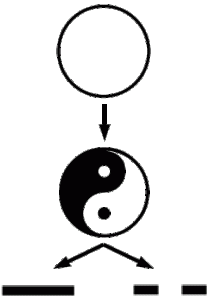
Wuji
“The journey of a thousand miles, starts under your feet.”
For all people on the Way, there are many paths with side excursions and a few distractions and even some “deviations”.
Any well thought out journey starts somewhere; indeed today even scientists think they can explain the origin of the universe. As fantastic as “the big bang theory” is….would you believe that well over 2500 years ago the planet’s original “scientists” the Taoists, had a similar theory?
According to the Taoist cosmology, before anything “existed” there was something they called “Wuji”. This (literally) means “the Void” or “without form” or “the beginning.” From this “Void”,”Tao” emerged, Tao being translated as “the Way” or “path”. An interesting side note corresponds to religious texts….”God created the Heaven and Earth”. For the Taoists you might look at it this way…’From the void, Tao emerged and created the heavens and Earth’.
Is it not sort of enlightening that Taoist thought can merge science and religion and validate both simultaneously? I tread lightly here so as to not evoke sensibilities, but let’s assume that the science of things is always open to scrutiny, and admit that religious texts were written thousands of years ago and are famous for using metaphorical language. Anyway, I’m only attempting to give some perspective to Wuji.
If you are still following me (and wondering what this has to do with Qigong) consider this, finding a “place” without form gives us a connection to divine origins. Notice my choice of words, crafted somewhere between the scientific and religious terminology. It is here where we see one way that “all things are connected”.
Along the Way we often find that science and religion merge into philosophy. By extrapolation it is easy to see that our physical self’s are connected to an understanding of the merger of the two (science and religion) into a philosophy. In the Taoist arts this philosophy is applied to the physical realm so that practitioners can assimilate cosmic energy directly into themselves.
One can see that practicing Qigong is an endeavor using a philosophy combined with science and spirituality, to nurture the physical self that contains our “Self” self.
Now don’t ever get put off by the talk of spirituality or the word “cosmic” as Taoists define these words in a general sense, for instance, tonight I am “inspired” to write this page, and so these words are coming from my “spirit” and as I post this message it is sent (via satellite) into the cosmos.
This stuff is not rocket science, nor is it some intangible “cosmic” thing; the fact is, this concept is so simple it is woefully misunderstood. My approach to Qigong (energy cultivation) is equally pragmatic, I’m not asking anyone to make any leap of faith; only to see the truth. With this understanding, we can now “start” the journey, also know, that by reading this, you already have…..
Copyright Cory Williams 2009
Next lesson








